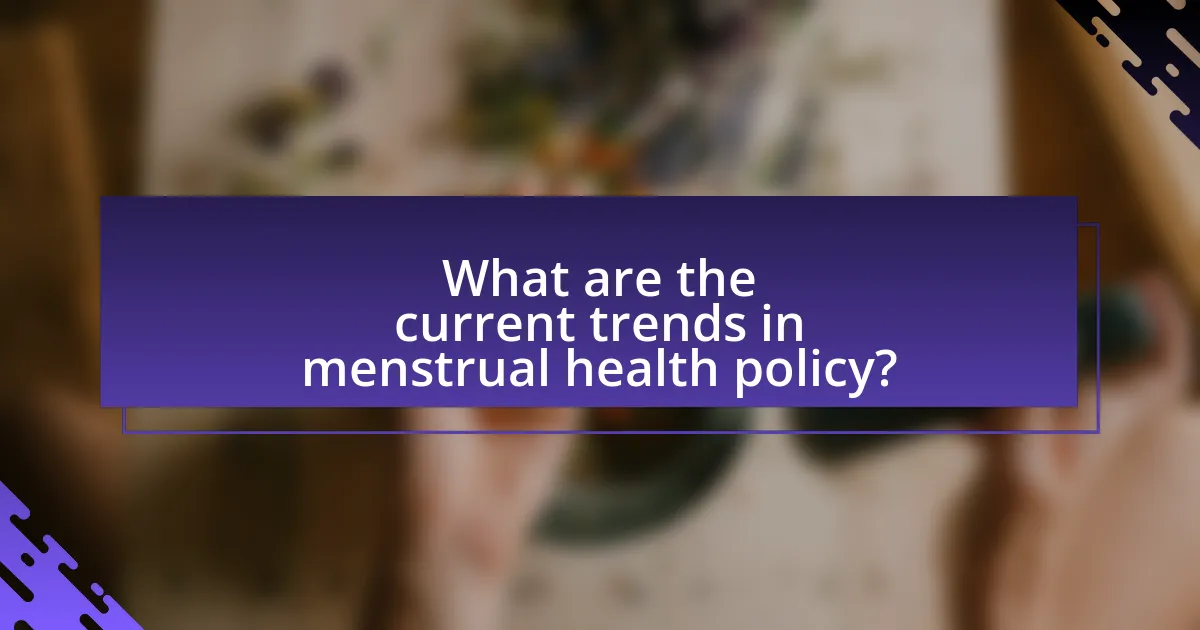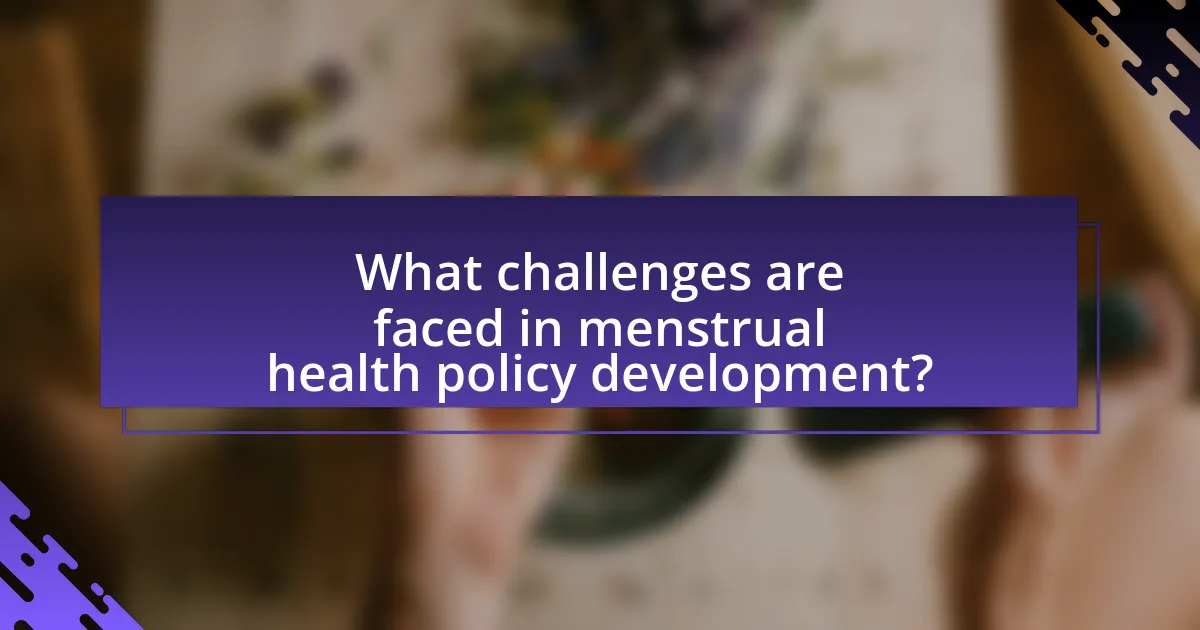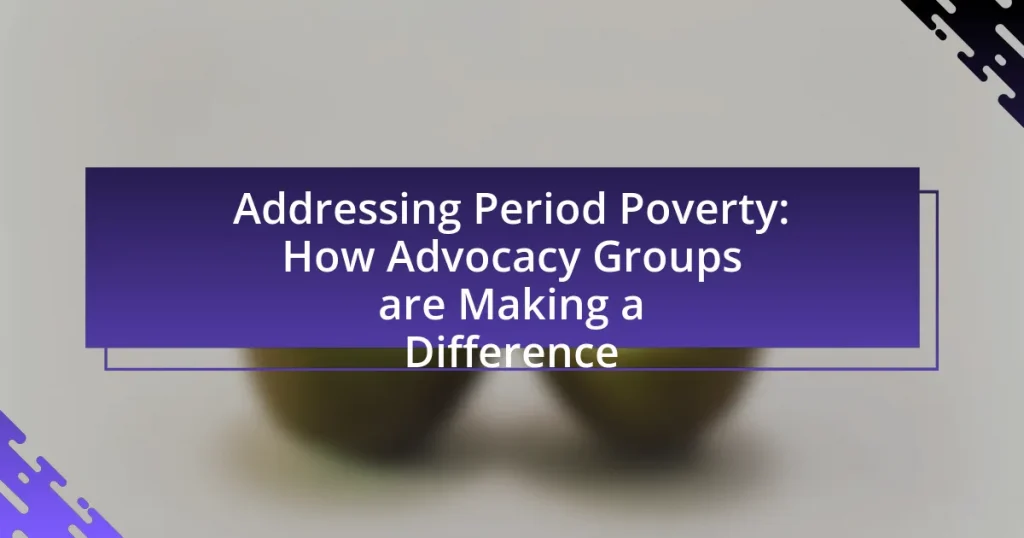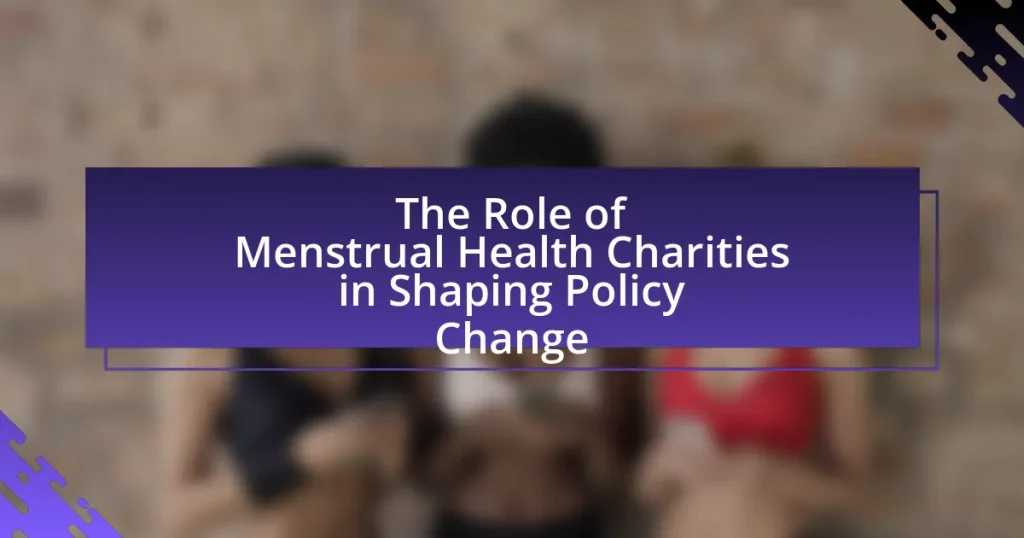The article focuses on the evolving landscape of menstrual health policy, highlighting current trends such as increased advocacy for menstrual equity, integration of menstrual health into broader health policies, and the importance of comprehensive education in schools. It examines changing societal attitudes towards menstruation, the role of education in shaping these perceptions, and the influence of cultural factors on policy development. Additionally, the article discusses innovations in menstrual health products, the impact of sustainable practices on policy, and the challenges faced in accessing menstrual health resources. It emphasizes the need for collaborative efforts among stakeholders to improve policy effectiveness and ensure inclusivity in addressing menstrual health issues.

What are the current trends in menstrual health policy?
Current trends in menstrual health policy include increased advocacy for menstrual equity, the integration of menstrual health into broader health policies, and the push for comprehensive education on menstrual health in schools. Advocacy groups are emphasizing the need for affordable menstrual products and access to hygiene facilities, particularly in low-income areas. Additionally, countries are beginning to recognize menstrual health as a critical component of public health, leading to policy reforms that aim to destigmatize menstruation and promote awareness. For instance, in 2021, Scotland became the first country to make menstrual products free for all, highlighting a significant shift towards recognizing menstrual health as a fundamental right.
How are societal attitudes towards menstruation changing?
Societal attitudes towards menstruation are increasingly becoming more open and accepting. This shift is evidenced by the growing visibility of menstrual health discussions in media, education, and public policy. For instance, campaigns advocating for menstrual equity and the removal of stigma have gained traction, leading to legislative changes in several countries that promote access to menstrual products and education. Research from the Menstrual Health Hub indicates that 70% of young people now feel comfortable discussing menstruation openly, compared to just 30% a decade ago. This change reflects a broader cultural movement towards normalizing menstruation and recognizing it as a vital aspect of health and well-being.
What role does education play in shaping these attitudes?
Education plays a crucial role in shaping attitudes towards menstrual health by providing knowledge and fostering awareness. Through comprehensive education programs, individuals gain an understanding of menstrual health, which can reduce stigma and promote positive attitudes. For instance, studies have shown that educational interventions in schools lead to increased knowledge about menstruation and improved attitudes among students, resulting in greater acceptance and support for menstrual health policies. This is evidenced by research conducted by the World Health Organization, which highlights that informed individuals are more likely to advocate for and engage in discussions about menstrual health, thereby influencing societal attitudes and policies.
How do cultural perceptions influence menstrual health policies?
Cultural perceptions significantly influence menstrual health policies by shaping societal attitudes towards menstruation, which in turn affects policy formulation and implementation. For instance, in cultures where menstruation is stigmatized, policies may lack adequate provisions for menstrual hygiene management, leading to inadequate access to sanitary products and education. Research by the World Bank indicates that in countries with strong menstrual taboos, such as India, only 12% of women use sanitary pads, which reflects how cultural beliefs can hinder effective health policies. Furthermore, cultural narratives can dictate the prioritization of menstrual health in public health agendas, often relegating it to a lower status compared to other health issues. This interplay between cultural perceptions and policy outcomes underscores the necessity for culturally sensitive approaches in developing effective menstrual health policies.
What innovations are emerging in menstrual health products?
Innovations in menstrual health products include the development of biodegradable menstrual products, smart menstrual tracking apps, and menstrual cups made from sustainable materials. Biodegradable products, such as organic cotton pads, reduce environmental impact, addressing the growing concern over plastic waste in traditional products. Smart apps utilize AI to provide personalized insights into menstrual cycles, enhancing user experience and health management. Additionally, menstrual cups made from silicone or rubber offer a reusable alternative, promoting sustainability and cost-effectiveness. These advancements reflect a shift towards eco-friendly and health-conscious solutions in menstrual health.
How are sustainable products impacting menstrual health policy?
Sustainable products are significantly influencing menstrual health policy by promoting eco-friendly practices and enhancing accessibility to menstrual hygiene products. The rise of biodegradable and reusable menstrual products, such as menstrual cups and organic cotton pads, has led policymakers to consider environmental impacts alongside health outcomes. For instance, countries like Canada and the UK have begun to integrate sustainability into their menstrual health policies, advocating for the use of sustainable products to reduce waste and improve public health. Research indicates that sustainable menstrual products can decrease the environmental footprint of menstrual waste, which aligns with global sustainability goals. This shift not only addresses environmental concerns but also encourages discussions around menstrual equity, as sustainable options can be more cost-effective in the long run, making them accessible to a broader population.
What technological advancements are being integrated into menstrual health solutions?
Technological advancements integrated into menstrual health solutions include mobile applications for tracking menstrual cycles, wearable devices for monitoring physiological symptoms, and telehealth platforms for remote consultations. These innovations enhance user engagement and provide personalized insights, improving overall menstrual health management. For instance, studies show that mobile apps can increase awareness and understanding of menstrual health, leading to better health outcomes. Additionally, wearable technology, such as smartwatches, can track hormonal changes and predict menstrual cycles with a reported accuracy of up to 90%. Telehealth services have also expanded access to healthcare professionals, allowing for timely advice and support, which is crucial for managing menstrual health effectively.
How are governments responding to menstrual health issues?
Governments are increasingly recognizing menstrual health issues as critical public health concerns and are implementing policies to address them. For instance, several countries have introduced initiatives to provide free menstrual products in schools and public facilities, aiming to reduce period poverty and improve access to hygiene. In 2020, Scotland became the first country to provide free menstrual products nationwide, a move supported by research indicating that lack of access can lead to negative health and educational outcomes for individuals who menstruate. Additionally, some governments are incorporating menstrual health education into school curricula, promoting awareness and reducing stigma. These actions reflect a growing commitment to addressing menstrual health as part of broader health and gender equality policies.
What policies are being implemented to improve access to menstrual products?
Governments and organizations are implementing various policies to improve access to menstrual products, including the removal of taxes on menstrual products, provision of free products in schools and public facilities, and initiatives to increase awareness and education about menstrual health. For instance, countries like Scotland have enacted legislation to provide free menstrual products in schools, colleges, and universities, ensuring that all individuals have access regardless of their financial situation. Additionally, some states in the U.S. have eliminated the “tampon tax,” which previously taxed menstrual products as luxury items, thereby reducing the overall cost for consumers. These policies aim to address period poverty and promote menstrual equity, ensuring that access to essential health products is recognized as a basic right.
How are public health campaigns addressing menstrual health awareness?
Public health campaigns are addressing menstrual health awareness by promoting education, reducing stigma, and increasing access to menstrual products. These campaigns utilize various platforms, including social media, community workshops, and school programs, to disseminate information about menstrual health, hygiene practices, and the importance of menstrual equity. For instance, initiatives like the “Menstrual Hygiene Day” campaign aim to raise awareness globally, highlighting the challenges faced by menstruators and advocating for policy changes. Research indicates that such campaigns can significantly improve knowledge and attitudes towards menstruation, as evidenced by a study published in the Journal of Adolescent Health, which found that targeted educational interventions led to a 40% increase in menstrual health knowledge among participants.

What challenges are faced in menstrual health policy development?
Menstrual health policy development faces several challenges, including stigma, lack of data, and inadequate funding. Stigma surrounding menstruation often leads to silence and misinformation, hindering effective policy formulation. Additionally, the absence of comprehensive data on menstrual health needs and outcomes complicates the creation of evidence-based policies. Furthermore, insufficient funding for menstrual health initiatives restricts the implementation and sustainability of programs aimed at improving menstrual health services. These challenges collectively impede progress in establishing effective menstrual health policies.
What barriers exist in accessing menstrual health products?
Barriers to accessing menstrual health products include financial constraints, lack of availability, stigma, and inadequate education. Financial constraints often prevent individuals from purchasing necessary products, as many low-income households struggle to afford them; for instance, a study by the Alliance for Period Supplies found that 1 in 5 low-income women have had to choose between buying menstrual products and other essential items. Lack of availability is prevalent in rural areas where stores may not stock these products, limiting access. Stigma surrounding menstruation can lead to shame and silence, discouraging individuals from seeking help or information. Additionally, inadequate education about menstrual health can result in misinformation and reluctance to discuss needs openly, further complicating access to products.
How do economic factors affect access to menstrual health solutions?
Economic factors significantly impact access to menstrual health solutions by influencing affordability, availability, and distribution of products. For instance, low-income individuals often face barriers to purchasing menstrual hygiene products due to their costs, which can lead to inadequate access and reliance on unsafe alternatives. According to a study published in the journal “BMC Women’s Health,” 1 in 5 women in low-income areas reported missing work or school due to lack of access to menstrual products, highlighting the direct correlation between economic status and menstrual health. Additionally, economic disparities can affect the infrastructure for distributing these products, particularly in rural or underserved areas, further exacerbating the issue.
What role does stigma play in hindering access to menstrual health resources?
Stigma significantly hinders access to menstrual health resources by creating a culture of silence and shame surrounding menstruation. This stigma leads to individuals feeling embarrassed or ashamed to seek necessary information and services, resulting in inadequate knowledge about menstrual health and limited access to essential products. Research indicates that in many cultures, menstruation is viewed as a taboo subject, which can discourage open discussions and education, further perpetuating misinformation and lack of resources. For example, a study published in the journal “BMC Women’s Health” found that stigma around menstruation directly correlates with lower rates of utilization of menstrual health services, highlighting the detrimental impact of societal attitudes on health access.
How do disparities in menstrual health policy affect different populations?
Disparities in menstrual health policy significantly affect different populations by creating unequal access to menstrual products, education, and healthcare services. For instance, low-income individuals and marginalized communities often face barriers such as high costs of menstrual products and lack of availability, leading to negative health outcomes and social stigma. According to a study published in the Journal of Women’s Health, 1 in 5 low-income women in the U.S. reported missing work or school due to lack of access to menstrual products. Additionally, cultural and regional differences can exacerbate these disparities, as some populations may not receive adequate education on menstrual health, further perpetuating misinformation and health risks. Thus, the lack of equitable menstrual health policies directly impacts the well-being and opportunities of affected populations.
What impact does socioeconomic status have on menstrual health access?
Socioeconomic status significantly impacts menstrual health access by influencing affordability, availability, and education regarding menstrual products and services. Individuals from lower socioeconomic backgrounds often face barriers such as limited financial resources, which restrict their ability to purchase menstrual hygiene products, leading to reliance on inadequate alternatives. Research indicates that 1 in 5 girls in the U.S. have missed school due to lack of access to menstrual products, highlighting the direct correlation between socioeconomic status and menstrual health access. Furthermore, lower socioeconomic status is associated with reduced access to healthcare services that provide education and support for menstrual health, exacerbating the challenges faced by these individuals.
How do geographic differences influence menstrual health policy effectiveness?
Geographic differences significantly influence the effectiveness of menstrual health policies by affecting access to resources, cultural perceptions, and healthcare infrastructure. For instance, urban areas often have better access to menstrual products and healthcare services compared to rural regions, where stigma and lack of education may hinder policy implementation. A study published in the Journal of Global Health found that in low-income countries, only 27% of women had access to sanitary products, highlighting the disparity based on geographic location. Additionally, cultural attitudes towards menstruation can vary widely; in some regions, menstruation is viewed as taboo, which can impede the acceptance and effectiveness of health policies aimed at improving menstrual health. Thus, geographic context plays a crucial role in shaping the success of menstrual health initiatives.
What are the implications of inadequate menstrual health policies?
Inadequate menstrual health policies lead to significant negative consequences for individuals and communities. These implications include increased absenteeism in schools and workplaces, as individuals may lack access to necessary menstrual products or face stigma, resulting in a loss of educational and economic opportunities. Research indicates that 1 in 5 girls in the U.S. have missed school due to menstruation, highlighting the impact of insufficient policies on education. Furthermore, inadequate policies can exacerbate health issues, as individuals may resort to unsafe practices during menstruation, increasing the risk of infections and reproductive health complications. The lack of comprehensive menstrual health education also perpetuates stigma and misinformation, hindering open discussions and support systems. Overall, the absence of effective menstrual health policies undermines gender equality and public health.
How does poor menstrual health policy affect women’s health outcomes?
Poor menstrual health policy negatively impacts women’s health outcomes by limiting access to necessary menstrual hygiene products and education. This lack of access can lead to increased rates of reproductive health issues, such as infections and complications related to menstruation. For instance, a study published in the journal “BMC Women’s Health” found that inadequate menstrual health management is associated with higher instances of absenteeism from school and work, which can further exacerbate socio-economic disparities. Additionally, poor policies can perpetuate stigma and misinformation surrounding menstruation, leading to mental health challenges among women and girls.
What are the long-term societal impacts of neglecting menstrual health issues?
Neglecting menstrual health issues leads to significant long-term societal impacts, including increased gender inequality and economic disadvantage. Women and girls who lack access to menstrual health resources often miss school or work, resulting in reduced educational and professional opportunities. For instance, a study by the Global Education Monitoring Report found that 1 in 10 girls in Africa misses school during their menstrual cycle, which can lead to a 20% reduction in lifetime earnings. Additionally, the stigma surrounding menstruation can perpetuate harmful cultural norms, further marginalizing women and hindering societal progress. This neglect ultimately affects public health systems, as untreated menstrual health issues can lead to chronic conditions, increasing healthcare costs and burdening healthcare systems.

What future directions can be anticipated in menstrual health policy?
Future directions in menstrual health policy will likely focus on increased accessibility to menstrual products, enhanced education on menstrual health, and the integration of menstrual health into broader health care frameworks. Governments and organizations are recognizing the importance of menstrual health as a critical aspect of public health, leading to initiatives aimed at reducing stigma and improving product availability. For instance, countries like Scotland have already implemented policies to provide free menstrual products in schools and public facilities, setting a precedent for similar measures globally. Additionally, there is a growing emphasis on incorporating menstrual health education into school curricula, which can empower individuals with knowledge about their bodies and health. These trends indicate a shift towards a more inclusive and supportive approach to menstrual health, addressing both practical needs and educational gaps.
How can collaboration between stakeholders improve menstrual health policy?
Collaboration between stakeholders can significantly improve menstrual health policy by fostering comprehensive approaches that integrate diverse perspectives and resources. When government agencies, healthcare providers, NGOs, and community organizations work together, they can identify gaps in existing policies and develop targeted interventions that address the specific needs of various populations. For instance, a study published in the Journal of Women’s Health highlighted that multi-stakeholder partnerships led to the successful implementation of menstrual health education programs in schools, resulting in increased awareness and reduced stigma. This collaborative effort not only enhances policy effectiveness but also ensures that menstrual health initiatives are culturally sensitive and accessible, ultimately leading to better health outcomes for individuals.
What roles do NGOs and community organizations play in shaping policy?
NGOs and community organizations play a critical role in shaping policy by advocating for marginalized voices, providing research and data, and mobilizing community engagement. These entities often identify gaps in existing policies and propose evidence-based solutions, influencing legislative agendas. For instance, organizations like the Global Fund for Women have successfully lobbied for improved menstrual health policies by highlighting the impact of menstrual stigma on women’s health and education. Their efforts have led to increased funding and policy changes in various countries, demonstrating the effectiveness of grassroots advocacy in driving systemic change.
How can private sector innovations contribute to policy advancements?
Private sector innovations can significantly contribute to policy advancements by providing data-driven insights and scalable solutions that address public health challenges. For instance, companies developing menstrual health products can leverage technology to gather user data, which can inform policymakers about the needs and preferences of consumers. A notable example is the use of mobile health applications that track menstrual cycles, offering valuable analytics that can guide policy decisions on reproductive health services. Furthermore, partnerships between private firms and government agencies can facilitate pilot programs that test new approaches to menstrual health, demonstrating effective strategies that can be adopted at a larger scale. This collaboration not only enhances the evidence base for policy but also accelerates the implementation of effective solutions in public health frameworks.
What best practices can be adopted for effective menstrual health policy?
Effective menstrual health policy should prioritize comprehensive education, access to menstrual products, and the integration of menstrual health into broader health services. Comprehensive education ensures that individuals understand menstrual health, reducing stigma and promoting informed choices. Access to affordable and quality menstrual products is crucial, as studies indicate that lack of access can lead to absenteeism in schools and workplaces. Furthermore, integrating menstrual health into general health services allows for a holistic approach, addressing related health issues and ensuring that menstrual health is recognized as a vital aspect of overall health. These practices are supported by evidence from various health organizations, which emphasize the importance of addressing menstrual health as part of public health initiatives.
How can data-driven approaches enhance policy development?
Data-driven approaches enhance policy development by providing empirical evidence that informs decision-making processes. These approaches enable policymakers to analyze trends, assess needs, and evaluate the effectiveness of existing policies through quantitative data, such as health statistics and demographic information. For instance, a study published in the Journal of Health Policy found that data analytics improved the targeting of health interventions, leading to a 30% increase in program effectiveness in addressing menstrual health issues. By leveraging data, policymakers can create more tailored and responsive policies that address specific community needs, ultimately leading to better health outcomes.
What strategies can be implemented to ensure inclusivity in menstrual health policy?
To ensure inclusivity in menstrual health policy, strategies must include stakeholder engagement, comprehensive education, and equitable access to resources. Engaging diverse stakeholders, including marginalized communities, ensures that policies reflect the needs of all individuals affected by menstruation. Comprehensive education programs that address cultural sensitivities and provide accurate information about menstrual health can empower individuals and reduce stigma. Additionally, ensuring equitable access to menstrual products and healthcare services, particularly for low-income and underserved populations, is crucial for fostering inclusivity. Research indicates that policies incorporating these strategies lead to improved health outcomes and greater acceptance of menstrual health issues across different demographics.
What practical steps can individuals take to advocate for better menstrual health policies?
Individuals can advocate for better menstrual health policies by engaging in grassroots activism, such as organizing community awareness campaigns and participating in local government meetings. These actions raise awareness about menstrual health issues and influence policymakers. For instance, studies show that public advocacy can lead to significant policy changes, as seen in countries where menstrual health initiatives gained traction through community-led efforts. Additionally, individuals can collaborate with organizations focused on menstrual health to amplify their voices and leverage resources for broader impact.



